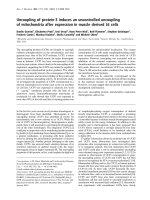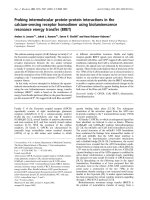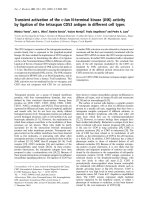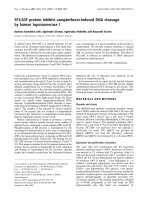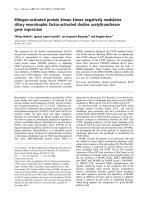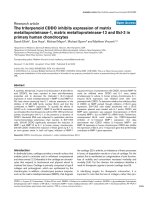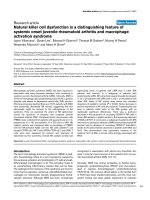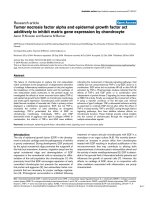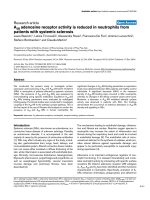Báo cáo y học: "Fibroblast activation protein alpha is expressed by chondrocytes following a pro-inflammatory stimulus and is elevated in osteoarthriti" docx
Bạn đang xem bản rút gọn của tài liệu. Xem và tải ngay bản đầy đủ của tài liệu tại đây (393.55 KB, 8 trang )
Open Access
Available online />Page 1 of 8
(page number not for citation purposes)
Vol 8 No 1
Research article
Fibroblast activation protein alpha is expressed by chondrocytes
following a pro-inflammatory stimulus and is elevated in
osteoarthritis
Jennifer M Milner
1
, Lara Kevorkian
2
, David A Young
1
, Debra Jones
1
, Robin Wait
3
, Simon T Donell
4
,
Emma Barksby
1
, Angela M Patterson
1
, Jim Middleton
5
, Benjamin F Cravatt
6
, Ian M Clark
2
,
Andrew D Rowan
1
and Timothy E Cawston
1
1
Musculoskeletal Research Group, Newcastle University, Newcastle upon Tyne, UK
2
School of Biological Sciences, University of East Anglia, Norwich, UK
3
Kennedy Institute of Rheumatology, Imperial College London, London, UK
4
School of Medicine, Institute of Health, University of East Anglia, Norwich, UK
5
Leopold Muller Arthritis Research Centre, School of Medicine, Keele University at Robert Jones and Agnes Hunt Orthopaedic Hospital, Oswestry,
UK
6
The Scripps Research Institute, La Jolla, CA 92037, USA
Corresponding author: Andrew D Rowan,
Received: 12 Jul 2005 Revisions requested: 22 Aug 2005 Revisions received: 21 Oct 2005 Accepted: 6 Dec 2005 Published: 3 Jan 2006
Arthritis Research & Therapy 2006, 8:R23 (doi:10.1186/ar1877)
This article is online at: />© 2005 Milner et al.; licensee BioMed Central Ltd.
This is an open access article distributed under the terms of the Creative Commons Attribution License ( />),
which permits unrestricted use, distribution, and reproduction in any medium, provided the original work is properly cited.
Abstract
Arthritis is characterised by the proteolytic degradation of
articular cartilage leading to a loss of joint function. Articular
cartilage is composed of an extracellular matrix of proteoglycans
and collagens. We have previously shown that serine
proteinases are involved in the activation cascades leading to
cartilage collagen degradation. The aim of this study was to use
an active-site probe, biotinylated fluorophosphonate, to identify
active serine proteinases present on the chondrocyte
membrane after stimulation with the pro-inflammatory cytokines
IL-1 and oncostatin M (OSM), agents that promote cartilage
resorption. Fibroblast activation protein alpha (FAPα), a type II
integral membrane serine proteinase, was identified on
chondrocyte membranes stimulated with IL-1 and OSM. Real-
time PCR analysis shows that FAP
α
gene expression is up-
regulated by this cytokine combination in both isolated
chondrocytes and cartilage explant cultures and is significantly
higher in cartilage from OA patients compared to phenotypically
normal articular cartilage. Immunohistochemistry analysis shows
FAPα expression on chondrocytes in the superficial zone of OA
cartilage tissues. This is the first report demonstrating the
expression of active FAPα on the chondrocyte membrane and
elevated levels in cartilage from OA patients. Its cell surface
location and expression profile suggest that it may have an
important pathological role in the cartilage turnover prevalent in
arthritic diseases.
Introduction
The proteolytic degradation of articular cartilage, leading to
loss of joint function, is a major characteristic of arthritis. Car-
tilage consists of an extracellular matrix composed mainly of
proteoglycans and collagens, in which chondrocytes, the only
cell type, are embedded [1]. Degradation of proteoglycan is
rapid and reversible but the breakdown of collagen is slow and
essentially irreversible. Thus, collagen degradation is a key
step in connective tissue breakdown.
The major extracellular proteolytic enzymes involved in carti-
lage resorption are the metallo- and serine proteinases, which
function through a series of interacting cascades. Matrix met-
alloproteinases (MMPs) are zinc-dependent endopeptidases
that, at neutral pH, are collectively able to degrade all compo-
nents of this extracellular matrix [2]. The collagenases (MMP-
1, MMP-8, MMP-13), membrane-type 1 MMP and gelatinase
(MMP-2) cleave fibrillar collagen into characteristic three-quar-
ter and one-quarter length fragments and so are key enzymes
involved in cartilage collagen turnover. Cleaved collagen is
DMEM = Dulbecco's modified Eagle's medium; DPPIV = dipeptidyl peptidase IV; FAPα = fibroblast activation protein alpha; FP-biotin = biotinylated
fluorophosphonate; IL = interleukin; MMP = matrix metalloproteinase; OA = osteoarthritis; OSM = oncostatin M; PBS = phosphate buffered saline;
PCR = polymerase chain reaction.
Arthritis Research & Therapy Vol 8 No 1 Milner et al.
Page 2 of 8
(page number not for citation purposes)
unstable, unwinds and is susceptible to non-specific proteoly-
sis. Degradation of the collagenous network is excessive in
arthritis[3], and elevated levels of MMPs are detected in
serum, synovial fluid, synovial membrane and cartilage from
patients with arthritis [4,5]. MMPs are regulated at critical
steps: synthesis, secretion, activation, inhibition, localization
and clearance [6]. Activation of pro-collagenases is a crucial
control point in determining if cartilage collagen resorption
occurs [7]. Serine proteinases are involved in these activation
cascades, although the exact serine proteinase(s) involved are
not known [7,8].
Over the past few years several membrane bound serine pro-
teinases have been identified [9]. Specific mechanisms local-
ize proteolysis to the cell surface, which can enhance activity,
limit the access of inhibitors, concentrate proteinases to their
specific target substrates and limit the extent of proteolysis to
discrete pericellular regions [6]. These mechanisms are impor-
tant for regulating proteolytic activity. In osteoarthritis (OA), ini-
tial collagen degradation is observed around chondrocytes
[3]. Thus, membrane bound MMPs and serine proteinases, as
well as secreted proteinases that localize to the cell, are all
important cell surface enzymes that could initiate this pericel-
lular proteolysis. Membrane bound serine proteinases are ide-
ally positioned to interact in these proteolytic cascades at the
cell surface. The expression and characterization of membrane
serine proteinases in joint tissues has not been studied and,
together with the observations described above, represent an
important and yet neglected area of cartilage biology.
The combination of the cytokines IL-1 and oncostatin M
(OSM) added to cartilage explant cultures synergistically
induces the synthesis and activation of proMMPs, leading to
cartilage collagen resorption [10]. IL-1 has been shown to be
involved in collagenase-mediated cleavage of collagen in OA
[11]. Increased levels of both cytokines are present in the
arthritic joint and adenoviral gene transfer of IL-1 in combina-
tion with OSM induces MMPs and joint damage in mice [12].
Many proteinases are regulated by complex post-transcrip-
tional mechanisms, the understanding of which requires anal-
ysis at the protein level. Biotinylated fluorophosphonate (FP-
biotin) is a rapid, specific and high-sensitivity probe enabling
direct proteomic profiling of serine hydrolase activities in crude
cell and tissue samples [13,14]. FP-biotin has been used pre-
viously to isolate active serine proteinases in complex pro-
teomes. The reactivity of FP with serine proteinases requires
the enzyme to be in a catalytically active state. FP-biotin binds
irreversibly to serine but not cysteine, aspartate and metallo-
proteinases and labelled proteins are then isolated using
streptavidin-agarose beads [13].
This is the first report showing the use of activity based profil-
ing to identify active serine proteinases on chondrocyte mem-
branes. We identify for the first time the expression of
fibroblast activation protein alpha (FAPα), an integral mem-
brane serine proteinase on chondrocyte membranes, under
conditions that promote cartilage resorption and elevated
expression in cartilage from OA patients.
Materials and methods
Materials
Recombinant human IL-1 was a generous gift from Dr Keith
Ray (GlaxoSmithKline, Stevenage, UK). Recombinant human
OSM was kindly donated by Professor John Heath (Depart-
ment of Biochemistry, University of Birmingham, UK). FP-biotin
was prepared as described previously [13,14].
Chondrocyte membrane purification
Bovine nasal chondrocytes were isolated from nasal septum
cartilage obtained from a local abattoir within 24 h of slaughter
as described previously [15]. Confluent bovine nasal chondro-
cytes stimulated with IL-1/OSM (1/10 ng/ml) for 24 h were
harvested and membrane extracts purified by sucrose-density-
gradient centrifugation as described previously [5]. Mem-
branes were resuspended in 50 mM TrisHCl pH 7.8, 0.2% v/
v Triton X-100.
Reactions between FP-biotin and chondrocyte
membranes
Chondrocyte membranes (20 mg/ml in 1.5 ml reaction vol-
ume) in 50 mM TrisHCl pH 7.8, 0.14% v/v Triton X-100, 160
mM NaCl were pre-absorbed with 50 µl of streptavidin-agar-
ose beads (Sigma-Aldrich, Poole, UK) for 1 h at 4°C with rota-
tion. Membranes were then incubated with FP-biotin (2 µM
from a 100 µM stock in dimethyl sulfoxide) for 90 minutes at
room temperature with rotation. As a control for non-specific
interactions, an equal amount of membranes was treated sim-
ilarly but omitting FP-biotin. Labelled proteins were isolated
using streptavidin-agarose beads, eluted proteins separated
on 10% SDS-PAGE and then stained with colloidal Coomas-
sie as described [14].
Mass spectrometry
Gel bands were excised, digested in gel with trypsin and ana-
lysed by tandem electrospray mass spectrometry using a Q-
Tof instrument (Waters, Manchester, UK) interfaced to a
Waters CapLC capillary chromatography system as previously
described [16]. Uninterpreted tandem mass spectra were
searched against a database constructed by merging Swiss-
Prot and TrEMBL database [17] as described [16]. Additional
sequences were obtained by manual interpretation of
unmatched spectra, and all deduced sequences were
searched against Uniprot using the program FASTS [18].
Chondrocyte cell culture
SW1353 human chondrosarcoma cells (ATCC, Manassas,
VA, USA) were routinely cultured in DMEM containing 10% v/
v fetal calf serum, 2 mM glutamine, 100 IU/ml penicillin, and
100 µg/ml streptomycin. Serum-free conditions used identical
Available online />Page 3 of 8
(page number not for citation purposes)
medium without fetal calf serum. For assays, cells were grown
to 85% confluence and then starved of serum for 24 h before
the addition of fresh serum-free medium with or without IL-1
and OSM. Experiments were performed in 12-well plates in
quadruplicate. RNA was isolated from monolayers using Trizol
reagent (Invitrogen, Paisley, UK).
Real-time PCR
Total RNA (1 µg) was reverse transcribed in a 20 µl reaction
using 2 µg of random hexamers and superscript II reverse tran-
scriptase (Invitrogen) according to the manufacturer's instruc-
tions. Oligonucleotide primers were designed using Primer
Express 1.0 software (Applied Biosystems, Warrington, UK).
To prevent amplification of any genomic DNA present, the
primers were placed within different exons close to, or span-
ning, the intron/exon boundary. Relative quantification of
genes was performed using the ABI Prism 7900HT sequence
detection system. FAP
α
expression was determined using
SYBR Green (Invitrogen) using the manufacturer's suggested
protocol. The primers used for human FAP
α
were: 5'-ATC-
TATGACCTTAGCAATGGAGAATTTGT-3' and 5'-GTTTT-
GATAGACATATGCTAATTTACTCCCAAC-3'. The primers
used for bovine FAP
α
were 5'-ACCATGAAAAGTGTGAAT-
GCTTCA-3' and 5'-AGTATCTCCAAAGCTTTGAATAAT-
CACTTTCT-3'. TaqMan GAPDH and 18S primers and probes
were purchased from Applied Biosystems. GAPDH gene
expression was used as an endogenous control in human cells
and cartilage to normalize for differences in the amount of total
RNA in each sample. In bovine samples, 18S expression was
used to normalize for differences as GAPDH primers and
probes did not recognize bovine GAPDH. TaqMan mastermix
reagents (Sigma-Aldrich) were used according to the manu-
facturer's protocol.
Bovine nasal cartilage degradation assay
Bovine nasal cartilage explants were cultured essentially as
described previously [10]. Briefly, 0.7 g of cartilage chips
(approximately 2 mm in diameter by 1 to 2 mm thick) from
bovine nasal septum cartilage were placed in T25 flasks and
incubated overnight in 10 ml of control, serum-free medium
(DMEM containing 25 mM HEPES, 2 mM glutamine, 100 µg/
ml streptomycin, 100 IU/ml penicillin, 2.5 µg/ml gentamicin
and 40 u/ml nystatin). Fresh control medium (10 ml) with or
without IL-1 (1 ng/ml) and OSM (10 ng/ml) (each condition in
triplicate) was then added (day 0). At day 7, culture superna-
tants were harvested and replaced with fresh medium contain-
ing the same test reagents as day 0. Cartilage and culture
supernatants were harvested at days 0, 1, 3, 5, 7, 8, 10, 12
and 14 and RNA was immediately extracted from cartilage as
described [5]. Hydroxyproline release was assayed as a meas-
ure of collagen degradation [10] and glycosaminoglycan
release was assayed as a measure of proteoglycan degrada-
tion [10]. Collagenase activity was determined by the
3
H-
acetylated collagen diffuse fibril assay using a 96-well plate
modification [19].
Extraction of RNA from human articular cartilage
Total RNA was extracted from human articular cartilage
obtained from femoral heads of patients undergoing total hip
replacement surgery at the Norfolk and Norwich University
Hospital as described [5]. This study was performed with Eth-
ics Committee approval, and all patients provided informed
consent. Samples from 14 patients with OA were compared
with cartilage from 12 patients undergoing hip replacement
following fracture of the femoral neck. OA was diagnosed by
clinical history and examination along with radiographic find-
ings; confirmation of gross pathologic findings was made at
the time of joint removal. The fracture patients had no known
history of joint disease and their cartilage was free of lesions.
These samples are referred to herein as normal cartilage. The
significance of differences between the control and OA
groups was determined using a two-sided Mann-Whitney U
test.
Immunohistochemistry of human articular cartilage
Samples of cartilage were obtained from five patients under-
going total knee replacement for tricompartmental/end-stage
OA. This study was performed with full approval from the
Shropshire ethics committee. Cartilage was snap frozen in iso-
pentene. Serial sections 10 µm thick were cut, air dried then
stored at -80°C until used. Tissue sections were equilibrated
to room temperature then fixed in ice cold acetone for 10 min-
utes. Sections were air-dried then rehydrated in PBS for 5 min-
utes. Endogenous peroxidase activity was blocked by
incubating tissue sections in 0.3%v/v H
2
O
2
for 15 minutes
then washed for 3 × 3 minutes in PBS. Non-specific binding
was blocked by incubating sections in 1.5% (v/v) horse serum
in PBS for 15 minutes followed by incubation for 1 h with 10
µg/ml mouse monoclonal antibody to FAPα (Bender MedSys-
tems, Middlesex, UK) or 10 µg/ml of a mouse IgG1 negative
control (Dako, Ely, UK). Antibody binding was detected and
visualised using horseradish peroxidase Vectastain ABC Elite
kit (Vector Laboratories, Peterborough, UK) followed by a 3,3'-
diaminobenzidine/nickel staining kit (Vector Laboratories).
Sections were then counterstained with Mayer's hematoxylin
solution (Sigma-Aldrich).
Results
Identification of FAPα in chondrocyte membrane
extracts
In OA, initial collagen degradation is observed around the peri-
cellular region surrounding the chondrocyte [3]. Thus, mem-
brane proteinases are ideally positioned to interact in
pericellular proteolysis. FP binds irreversibly to active serine
proteinases; therefore, we have used FP-biotin to probe
chondrocyte membranes for serine proteinase activities. We
have previously shown that the addition of IL-1 plus OSM to
cartilage explant cultures results in cartilage resorption [10].
To identify serine proteinases synthesized by chondrocytes
under these conditions, bovine nasal cartilage chondrocytes
were stimulated with IL-1 plus OSM for 24 h. The use of
Arthritis Research & Therapy Vol 8 No 1 Milner et al.
Page 4 of 8
(page number not for citation purposes)
bovine cells enabled large-scale preparation of membranes for
protein identification by mass spectrometry. Following incuba-
tion of chondrocyte membranes with FP-biotin, a major band
was observed at approximately 97 kDa (Figure 1). This was
not detected in membranes incubated in the absence of FP-
biotin, confirming specificity. Tandem mass spectrometry ena-
bled sequencing of 11 peptides (162 amino acid residues:
Table 1) from the tryptic digest of the 97 kDa band. When
searched against the Uniprot database using FASTS [18],
these deduced amino acid sequences matched human FAPα
(Uniprot ID:Q12884) with 95% identity (the bovine ortholog is
not yet present in any publicly available protein database). The
slight divergence from the human sequence (for example,
deletion of G143; Table 1) was comparable to that between
human and mouse FAPα. Thus, probing the chondrocyte
membrane with FP-biotin has identified active FAPα.
Regulation of FAP
α
gene expression in chondrocytes
The regulation of FAPα gene expression by IL-1 and OSM,
cytokines known to promote cartilage resorption, was investi-
gated in the SW1353 chondrocytes using real-time PCR (Fig-
ure 2). IL-1 alone induces low levels of FAPα gene expression
and OSM alone induces higher expression, while the combi-
nation of IL-1 and OSM further increases FAPα expression.
Thus, FAPα expression is up-regulated under conditions that
promote cartilage resorption.
Figure 1
Biotinylated fluorophosphonate (FP-biotin) labelling of fibroblast activa-tion protein alpha (FAPα) on chondrocyte membranesBiotinylated fluorophosphonate (FP-biotin) labelling of fibroblast activa-
tion protein alpha (FAPα) on chondrocyte membranes. Membrane
extracts isolated from IL-1 plus oncostatin M stimulated chondrocytes
were treated with or without FP-biotin. Labelled proteinases were iso-
lated using streptavidin-agarose beads and eluted with reducing SDS-
PAGE loading buffer. Proteins were separated by SDS-PAGE and
stained with colloidal Coomassie. The 97 kDa protein was identified by
mass spectrometry to be FAPα.
Table 1
Peptide sequence confirmation of bovine fibroblast activation
protein alpha from chondrocyte membranes.
m/z (Charge) Location
a
Sequence
564.78 (2+) 335–343 TQEHIEESR
736.77 (2+) 367–375 IFSDKDGYK
611.30 (3+) 210–219 YALWWSPNGK
751.41 (2+) 162–173 LAYVYQNNIYLK
796.41 (2+) 592–605 LGVYEVEDQITAVR
969.56 (2+) 534–550 YPLLIQVYGGPCSQSVR
697.41 (2+) 510–521 LKVDDITLWYK
786.47 (2+) 551–564 SIFAVSWISYLASK
715.65 (3+) 144–161 NELPRPIQYLCWSPVGSK
776.36 (3+) 124–142 YSYTATYHIYDLTNGEFIR
1098.96 (2+) 403–421 VTQDSLFYSSNEFEGYPGR
The 97 kDa band obtained following biotinylated fluorophosphonate
labelling of bovine chondrocytes was trypsin digested and analysed
using mass spectrometry; 11 separate peptides were detected.
a
Numbering according to uniprot entry Sepr_Human. Human has Y
not H in position 131, G143 is deleted in the bovine sequence,
human has E not G in position 417, E not K at 511, E not D at 514, V
not I at 552, and N not S at 556.
Figure 2
FAP
α
gene expression is upregulated by IL-1 and oncostatin M (OSM) in chondrocytesFAP
α
gene expression is upregulated by IL-1 and oncostatin M (OSM)
in chondrocytes. SW1353 cells were treated with combinations of IL-1
and OSM for 24 h. Total RNA was extracted and FAP
α
gene expres-
sion determined by real-time PCR as described in Materials and meth-
ods. The data are presented relative to GAPDH, and are representative
of four separate experiments. * = P < 0.05, *** = P < 0.001 versus
control
Available online />Page 5 of 8
(page number not for citation purposes)
Regulation of FAP
α
gene expression in resorbing
cartilage
Collagenases degrade cartilage collagen and our previous
work has shown that serine proteinases are involved in the
cascades leading to activation of these pro-collagenases
[7,8]. To determine if FAPα is expressed in resorbing cartilage,
the expression of FAP
α
was investigated in an IL-1 plus OSM
induced bovine nasal cartilage degradation assay (Figure 3).
IL-1 plus OSM induces a rapid breakdown of proteoglycan,
with over 80% release by day 5 of culture (data not shown).
Active collagenase is first detected at day 10 of culture (data
not shown), followed by a rapid release of collagen fragments
(Figure 3). FAP
α
gene expression is significantly induced at
days 7 to 14 of culture (Figure 3). The lower level of FAP
α
induction seen at days 8 to 9 is likely due to the effects of
changing the medium and re-stimulating the cartilage with
cytokines at day 7. FAP
α
gene expression is induced in
resorbing cartilage after proteoglycan release, but prior to and
during collagen release, thus suggesting that FAPα could be
associated with the mechanisms leading to cartilage collagen
degradation.
FAP
α
gene expression in human articular cartilage
To evaluate the expression of FAPα in arthritic disease, the lev-
els of FAPαgene expression were compared in normal and
osteoarthritic cartilage (Figure 4). FAPα gene expression is
significantly higher in osteoarthritic (mean = 61.1) compared
to normal (mean = 16.1) cartilage (P = 0.0009).
Immunohistochemistry analysis of FAPα in cartilage
from OA patients
Immunodetection of FAPα was demonstrated in all cartilage
sections from OA patients examined (n = 5). Staining was
observed in the superficial zone (Figure 5a,c) and on the
chondrocyte membrane (Fig. 5b). No immunostaining was
observed in OA cartilage treated with a negative control non-
immune mouse IgG (Figure 5d).
Discussion
We report for the first time the use of activity-based probes to
identify proteinases in resorbing cartilage. This is the first
study to show that chondrocytes synthesize FAPα (also
known as seprase) when stimulated with the pro-inflammatory
cytokines IL-1 and OSM. FAP
α
gene expression is induced
just prior to collagen degradation in a model of cartilage
resorption, thus suggesting that FAPα is associated with col-
lagen resorption. Furthermore, FAP
α
gene expression is sig-
nificantly elevated in cartilage from patients with OA.
Immunohistochemistry analysis shows staining for FAPα on
chondrocytes in the superficial zone of OA cartilage. In OA,
the superficial zone is characterised by fibrillations and degen-
erative matrix changes, and proteinases involved in cartilage
resorption, such as the collagenases (MMP-1, MMP-8 and
MMP-13), also show highest expression in the superficial zone
of OA cartilage [20]. These observations support a role for
FAPα in the mechanisms leading to cartilage degeneration in
OA.
FAPα was initially identified as a cell surface glycoprotein
present on stromal fibroblasts of human epithelial cancers [21]
and on the invadopodia of a human malignant melanoma cell
Figure 3
FAP
α
gene expression is induced in resorbing cartilageFAP
α
gene expression is induced in resorbing cartilage. Bovine nasal
cartilage chips were cultured in medium with or without IL-1 (1 ng/ml)
and oncostatin M (OSM; 10 ng/ml) for 14 days. At day 7, medium was
removed and the cartilage was replenished with identical reagents. Car-
tilage and medium were harvested at days 0, 1, 3, 5, 7, 8, 10, 12 and
14. Each time-point and condition were performed in triplicate. As a
measure of collagen, the levels of hydroxyproline released into the
media from unstimulated (control) and IL-1/OSM stimulated cartilage
were assayed and cumulative hydroxyproline release is shown. Values
are the mean ± standard error of the mean. RNA was extracted from
cartilage and FAP
α
gene expression was determined by real-time PCR
as described in Materials and methods. The data are presented relative
to 18S and show fold induction of FAP
α
by IL-1/OSM compared to
control treatments.
Figure 4
FAP
α
gene expression is upregulated in osteoarthritic cartilageFAP
α
gene expression is upregulated in osteoarthritic cartilage. Total
RNA was extracted from osteoarthritic hip cartilage (n = 14) and phe-
notypically normal hip cartilage from patients with femoral neck fracture
(n = 12). FAP
α
gene expression was determined by real-time PCR as
described in Materials and methods. The data are presented relative to
GAPDH. FAP
α
gene expression is significantly higher in osteoarthritic
cartilage (OA) compared to normal cartilage (P = 0.0009).
Arthritis Research & Therapy Vol 8 No 1 Milner et al.
Page 6 of 8
(page number not for citation purposes)
line LOX, which exhibits aggressive behaviour in experimental
metastasis [22,23]. Immunohistochemistry has shown that
FAPα is transiently expressed in certain normal fetal mesen-
chymal tissues, but in normal adult tissues FAPα expression is
absent. Most of the common types of epithelial cancers,
including over 90% of breast, lung and colorectal carcinomas,
contain abundant FAPα expression. It is strongly expressed by
the reactive tumour stromal fibroblasts surrounding the newly
formed blood vessels of epithelial cancers and in reactive
fibroblasts found in the granulation tissue of healing wounds
[21]. FAPα is also expressed by stellate cells at the tissue
remodelling interface in human cirrhosis but not in normal liv-
ers [24]. Thus, FAPα is expressed in many pathologies.
FAPα is a type II transmembrane serine proteinase with a cyto-
plasmic tail that contains six amino acids followed by a 20
amino acid transmembrane domain at the amino terminus, a
region with several potential N-glycosylation sites, a cysteine
rich substrate-binding domain and a stretch of 200 amino
acids at the carboxyl terminus containing the catalytic serine,
aspartate and histidine in a non-classical orientation [25,26].
The active enzyme is a homodimer that contains two 97 kDa
subunits [27]. FAPα is structurally very similar to dipeptidyl
peptidase IV (DPPIV). Both enzymes have dipeptidyl pepti-
dase activity and cleave prolyl peptide bonds (Pro-Xaa).
DPPIV has a variety of known substrates, including chemok-
ines, growth factors, neuropeptides and vasoactive peptides;
however, the natural ligand of FAPα is not known. FAPα has
been shown to have both exo- and endopeptidase activity and
can cleave gelatin [24,28]. Thus, during cartilage resorption
FAPα may contribute to the degradation of denatured
collagen (gelatin) after the initial cleavage by collagenases.
FAPα associates with DPPIV, MMP-2, membrane-type 1 MMP
and urokinase plasminogen activator receptor at invadopodia
of human malignant melanoma cells [22,29] and so may inter-
act with these proteinases and receptors and associated cas-
cades. For example, DPPIV and FAPα can form a complex
localised at invadopodia of fibroblasts on collagenous fibres
that has both gelatinolytic and gelatin binding activities, which
allow cell migration [30].
In a murine collagen-induced arthritis model, gene-expression
profiling using the Mu11K array (Affymetrix) showed a seven-
fold increase in FAP
α
gene expression together with MMP
expression in inflamed, compared to non-inflamed, paws [31].
In addition, FAP
α
maps to a chromosomal region containing
collagen-induced arthritis linked susceptibility loci [32], which
is also consistent with a role in arthritis. The FAP
α
ortholog in
Xenopus laevis has been reported to be induced during tad-
pole metamorphosis [33], a process intimately associated
with collagenolysis. The first collagenase enzyme was isolated
from such tissue [34]. Furthermore, FAP
α
is also induced at
Figure 5
Immunolocalisation of FAPα protein in osteoarthritic (OA) cartilageImmunolocalisation of FAPα protein in osteoarthritic (OA) cartilage. (a) FAPα in OA cartilage specimen 1. Note positive staining (brown/black) of
cells in the superficial zone. Boxed region represents low-power view of Figure 5b. (b) High-power view of FAPα in OA cartilage specimen 1. Note
positive staining of the chondrocyte membrane (arrow). (c) FAPα in OA cartilage specimen 2. Note positive staining of cells in the superficial zone.
(d) OA cartilage specimen 2 treated with non-immune mouse IgG as a negative control for FAPα.
Available online />Page 7 of 8
(page number not for citation purposes)
regions of active tissue remodelling during mouse embryogen-
esis, including somites and perichondrial mesenchyme from
cartilage primordia [35].
These data and our own observations clearly support a role for
FAPα in tissue remodelling processes during normal develop-
ment and in pathology. Further studies are required to deter-
mine the exact mechanistic role of FAPα in tissue proteolysis.
Conclusion
Using an active-site probe, we have identified for the first time
active FAPα, a serine proteinase on the chondrocyte mem-
brane. We have shown that FAP
α
gene expression is up-reg-
ulated by pro-inflammatory cytokines IL-1 and OSM in
chondrocytes and is induced during cartilage collagen resorp-
tion. Furthermore FAP
α
gene expression is significantly ele-
vated in cartilage from OA patients when compared to age-
matched normal controls. Immunohistochemistry analysis of
cartilage from OA patients shows FAPα staining on chondro-
cytes in the superficial zone. Although the exact function of
FAPα remains to be elucidated, we clearly show an associa-
tion between FAPα and chondrocytes in the context of carti-
lage degradation. The surface location of FAPα ideally
positions it for a role in pathological pericellular tissue
degradation and remodelling in cartilage as is seen in arthritic
diseases.
Competing interests
The authors declare that they have no competing interests.
Authors' contributions
JMM helped conceive, design and coordinate the study and
carried out membrane preparations, FP-biotin experiments,
preparation of cDNA from bovine cartilage, real-time PCR,
immunohistochemistry and drafted the manuscript. LK pre-
pared cDNA from cartilage. DAY coordinated human cartilage
collection and cDNA preparation and helped with preparation
of cDNA from bovine cartilage. DJ carried out tissue culture.
RW carried out the mass spectrometry. BFC prepared the FP-
biotin. STD collected cartilage from joint replacement surgery.
IMC coordinated human cartilage collection and cDNA prepa-
ration. EB prepared cartilage sections for immunohistochem-
istry. AMP collected and prepared cartilage for
immunohistochemistry. JM coordinated collection of OA
cartilage for immunohistochemistry. ADR helped to conceive,
design and coordinate the study and draft the manuscript.
TEC helped to conceive, design and coordinate the study and
draft the manuscript. All authors read and approved the final
manuscript.
Acknowledgements
JMM is funded by the Dunhill Medical Trust and Arthritis Research Cam-
paign. LK is funded by an Industrial CASE studentship from BBSRC
(Biotechnology and Biological Sciences Research Council) and Astra-
Zeneca. DAY is funded by the JGW Pattinson Trust. DJ is funded by the
Dunhill Medical Trust.
References
1. Goldring MB: The role of the chondrocyte in osteoarthritis.
Arthritis Rheum 2000, 43:1916-1926.
2. Birkedal-Hansen H, Moore WG, Bodden MK, Windsor LJ,
Birkedal-Hansen B, DeCarlo A, Engler JA: Matrix metalloprotein-
ases: a review. Crit Rev Oral Biol Med 1993, 4:197-250.
3. Hollander AP, Pidoux I, Reiner A, Rorabeck C, Bourne R, Poole
AR: Damage to type II collagen in aging and osteoarthritis
starts at the articular surface, originates around chondrocytes,
and extends into the cartilage with progressive degeneration.
J Clin Invest 1995, 96:2859-2869.
4. Clark IM, Parker AE: Metalloproteinases: their role in arthritis
and potential as therapeutic targets. Expert Opin Ther Targets
2003, 7:19-34.
5. Kevorkian L, Young DA, Darrah C, Donell ST, Shepstone L, Porter
S, Brockbank SM, Edwards DR, Parker AE, Clark IM: Expression
profiling of metalloproteinases and their inhibitors in cartilage.
Arthritis Rheum 2004, 50:131-141.
6. Sternlicht MD, Werb Z: How matrix metalloproteinases regu-
late cell behavior. Annu Rev Cell Dev Biol 2001, 17:463-516.
7. Milner JM, Elliott SF, Cawston TE: Activation of procollagenases
is a key control point in cartilage collagen degradation: inter-
action of serine and metalloproteinase pathways. Arthritis
Rheum 2001, 44:2084-2096.
8. Milner JM, Rowan AD, Elliott SF, Cawston TE: Inhibition of furin-
like enzymes blocks interleukin-1alpha/oncostatin M-stimu-
lated cartilage degradation. Arthritis Rheum 2003,
48:1057-1066.
9. Netzel-Arnett S, Hooper JD, Szabo R, Madison EL, Quigley JP,
Bugge TH, Antalis TM: Membrane anchored serine proteases:
a rapidly expanding group of cell surface proteolytic enzymes
with potential roles in cancer. Cancer Metastasis Rev 2003,
22:237-258.
10. Cawston TE, Curry VA, Summers CA, Clark IM, Riley GP, Life PF,
Spaull JR, Goldring MB, Koshy PJ, Rowan AD, et al.: The role of
oncostatin M in animal and human connective tissue collagen
turnover and its localization within the rheumatoid joint. Arthri-
tis Rheum 1998, 41:1760-1771.
11. Kobayashi M, Squires GR, Mousa A, Tanzer M, Zukor DJ, Antoniou
J, Feige U, Poole AR: Role of interleukin-1 and tumor necrosis
factor alpha in matrix degradation of human osteoarthritic
cartilage. Arthritis Rheum 2005, 52:128-135.
12. Rowan AD, Hui W, Cawston TE, Richards CD: Adenoviral gene
transfer of interleukin-1 in combination with oncostatin M
induces significant joint damage in a murine model. Am J
Pathol 2003, 162:1975-1984.
13. Liu Y, Patricelli MP, Cravatt BF: Activity-based protein profiling:
the serine hydrolases. Proc Natl Acad Sci USA 1999,
96:14694-14699.
14. Kidd D, Liu Y, Cravatt BF: Profiling serine hydrolase activities in
complex proteomes. Biochemistry 2001, 40:4005-4015.
15. Billington CJ, Clark IM, Cawston TE: An aggrecan-degrading
activity associated with chondrocyte membranes. Biochem J
1998, 336:207-212.
16. Hermansson M, Sawaji Y, Bolton M, Alexander S, Wallace A,
Begum S, Wait R, Saklatvala J: Proteomic analysis of articular
cartilage shows increased type II collagen synthesis in oste-
oarthritis and expression of inhibin betaA (activin A), a regula-
tory molecule for chondrocytes. J Biol Chem 2004,
279:43514-43521.
17. The Swiss-Prot Protein Database [ />]
18. Mackey AJ, Haystead TA, Pearson WR: Getting more from less:
algorithms for rapid protein identification with multiple short
peptide sequences. Mol Cell Proteomics 2002, 1:139-147.
19. Koshy PJ, Rowan AD, Life PF, Cawston TE: 96-Well plate assays
for measuring collagenase activity using (3)H-acetylated
collagen. Anal Biochem 1999, 275:202-207.
20. Tetlow LC, Adlam DJ, Woolley DE: Matrix metalloproteinase and
proinflammatory cytokine production by chondrocytes of
human osteoarthritic cartilage: associations with degenera-
tive changes. Arthritis Rheum 2001, 44:585-594.
21. Garin-Chesa P, Old LJ, Rettig WJ: Cell surface glycoprotein of
reactive stromal fibroblasts as a potential antibody target in
human epithelial cancers. Proc Natl Acad Sci USA 1990,
87:7235-7239.
Arthritis Research & Therapy Vol 8 No 1 Milner et al.
Page 8 of 8
(page number not for citation purposes)
22. Monsky WL, Lin CY, Aoyama A, Kelly T, Akiyama SK, Mueller SC,
Chen WT: A potential marker protease of invasiveness,
seprase, is localized on invadopodia of human malignant
melanoma cells. Cancer Res 1994, 54:5702-5710.
23. Aoyama A, Chen WT: A 170-kDa membrane-bound protease is
associated with the expression of invasiveness by human
malignant melanoma cells. Proc Natl Acad Sci USA 1990,
87:8296-8300.
24. Levy MT, McCaughan GW, Abbott CA, Park JE, Cunningham AM,
Muller E, Rettig WJ, Gorrell MD: Fibroblast activation protein: a
cell surface dipeptidyl peptidase and gelatinase expressed by
stellate cells at the tissue remodelling interface in human
cirrhosis. Hepatology 1999, 29:1768-1778.
25. Scanlan MJ, Raj BK, Calvo B, Garin-Chesa P, Sanz-Moncasi MP,
Healey JH, Old LJ, Rettig WJ: Molecular cloning of fibroblast
activation protein alpha, a member of the serine protease fam-
ily selectively expressed in stromal fibroblasts of epithelial
cancers. Proc Natl Acad Sci USA 1994, 91:5657-5661.
26. Goldstein LA, Ghersi G, Pineiro-Sanchez ML, Salamone M, Yeh Y,
Flessate D, Chen WT: Molecular cloning of seprase: a serine
integral membrane protease from human melanoma. Biochim
Biophys Acta 1997, 1361:11-19.
27. Pineiro-Sanchez ML, Goldstein LA, Dodt J, Howard L, Yeh Y, Tran
H, Argraves WS, Chen WT: Identification of the 170-kDa
melanoma membrane-bound gelatinase (seprase) as a serine
integral membrane protease. J Biol Chem 1997,
272:7595-7601.
28. Aertgeerts K, Levin I, Shi L, Snell GP, Jennings A, Prasad GS,
Zhang Y, Kraus ML, Salakian S, Sridhar V, et al.: Structural and
kinetic analysis of the substrate specificity of human fibroblast
activation protein Alpha. J Biol Chem 2005, 280:19441-19444.
29. Artym VV, Kindzelskii AL, Chen WT, Petty HR: Molecular proxim-
ity of seprase and the urokinase-type plasminogen activator
receptor on malignant melanoma cell membranes: depend-
ence on beta1 integrins and the cytoskeleton. Carcinogenesis
2002, 23:1593-1601.
30. Ghersi G, Dong H, Goldstein LA, Yeh Y, Hakkinen L, Larjava HS,
Chen WT: Regulation of fibroblast migration on collagenous
matrix by a cell surface peptidase complex. J Biol Chem 2002,
277:29231-29241.
31. Ibrahim SM, Koczan D, Thiesen HJ: Gene-expression profile of
collagen-induced arthritis. J Autoimmun 2002, 18:159-167.
32. McIndoe RA, Bohlman B, Chi E, Schuster E, Lindhardt M, Hood L:
Localization of non-Mhc collagen-induced arthritis suscepti-
bility loci in DBA/1j mice. Proc Natl Acad Sci USA 1999,
96:2210-2214.
33. Brown DD, Wang Z, Furlow JD, Kanamori A, Schwartzman RA,
Remo BF, Pinder A: The thyroid hormone-induced tail resorp-
tion program during Xenopus laevis metamorphosis. Proc
Natl Acad Sci USA 1996, 93:1924-1929.
34. Gross J, Lapiere CM: Collagenolytic activity in amphibian tis-
sues: a tissue culture assay. Proc Natl Acad Sci USA 1962,
48:1014-1022.
35. Niedermeyer J, Garin-Chesa P, Kriz M, Hilberg F, Mueller E, Bam-
berger U, Rettig WJ, Schnapp A: Expression of the fibroblast
activation protein during mouse embryo development. Int J
Dev Biol 2001, 45:445-447.

